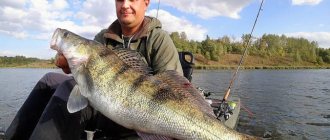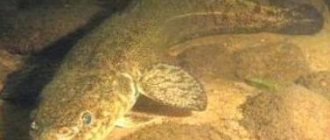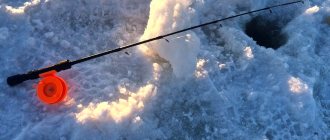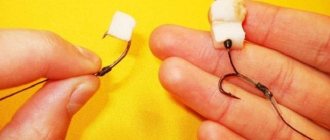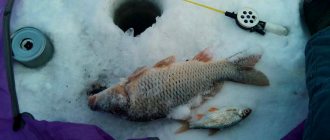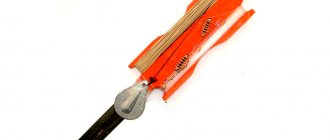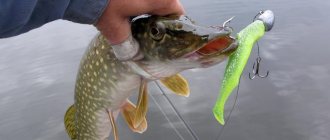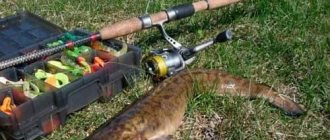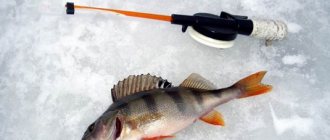Description
A flattened wide face, a large mouth, small “sassy” eyes and an elongated mustache on the chin - this is what this fish looks like. Burbot hunts mainly at night, and in muddy water. In the dark, he carefully probes the bottom with his rather sensitive mustache, opens his wide mouth excessively and easily swallows worms or frogs, not disdaining even dead fish.
Burbot is a fish without scales. It's coated in a nasty, soapy slime, so fishermen know how difficult it can be to hold in their hands. This representative of cod is elastic; it twists and turns, trying to escape from the palms. It’s not for nothing that there is an expression about him: “Slippery as burbot.” It can only be held by grasping it by the gills.
Fishing
Almost all lovers of autumn and winter “silent hunting” know that the most successful time of catching burbot is in November. This fish has white and very tender meat, but its truly huge liver is especially valued. Gourmets consider it a delicacy.
Fishing in November is a great time to catch burbot. This month is the time when you can go to the reservoir for this fish purposefully, since during this period he leads the most active lifestyle. It bites on almost any bait.
But despite this, you need to prepare in advance for fishing for this predatory fish. Catching burbot in November requires the fisherman to have special knowledge and skills. Despite the great activity of this fish, those who go to the reservoir after it must have the correct gear selected and prepared and their habitat determined.
Useful tips and facts
Recommendations and facts that will help make fishing more productive:
- When fishing passively, you need to carefully monitor the tackle, and it is better to equip it with a bite alarm. This is necessary because The initial bite of burbot is almost unnoticeable, reminiscent of a slight tug. But when fishing, the predator begins to actively resist.
- If the fishing area has a lot of stones and snags, then it is better to use a fishing line with the maximum allowable thickness. Thanks to this, when caught, you will be able to free yourself without fear of breaking the equipment.
- When fishing in places with snags, you can use a silicone bait with a double as bait. It will close the hook, thereby avoiding snags.
- In November it is already very cold outside, so you need to take care of warm clothing, incl. about a change of clothes and shoes in case of getting wet. You also need to take hot food and tea when fishing, because sometimes you have to sit on the shore for a very long time.
- If ice has already formed in November, it is not recommended to step on it, because it is still too thin.
Summing up, we can conclude that the most suitable period for catching burbot on the Oka and other Russian reservoirs is November. It is in this month that the water has a consistently low temperature (less than +13 degrees), at which the predator becomes active and is good at various baits.
This is interesting: Alarm suitcase: What's inside?
You need to go fishing at night. If it is not possible to sit on the shore with a spinning rod, then you can place passive gear along it and go about your business or even go home until the morning. However, to make fishing more effective, it is still recommended to use active fishing techniques.
We also recommend very useful material about catching burbot using a line.
Where to catch November burbot
Fishing will be successful if you first choose the right place. When the water temperature drops below six degrees, the linen stops pecking for a while. At this time, the young animals fall into a kind of torpor, and therefore become more accessible to predators. Apparently, this is why nature decreed that burbot switch to feeding in November.
At the end of autumn, he chooses those places where there is a sufficient amount of food. As a rule, his attention is paid to the night stays of small fish. Usually, closer to night, they move closer to streams with weak currents, while in stagnant bodies of water they usually stay close to the bank edges.
As the temperature drops, burbot also moves to the coastal zone in November, leaving the riverbeds, holes and snags. In reservoirs with fast currents, it chooses those places where the “return” is weak. This cod fish does not like those areas whose bottom is hidden under silt or under dense vegetation.
Experienced fishermen know how to catch burbot in November. They find this fish by trial and error, casting gear at different distances from the shore and at different depths. Wherever the bite occurs, that’s where you need to subsequently install the tackle. Moreover, in this area for several years in a row there can be quite successful burbot fishing in November.
Burbot on the feeder
Those who like to warm themselves by the night fire use feeder fishing. To effectively catch burbot on a feeder, it is enough to take several tackles with you.
One or two tackles are thrown into promising places, and one tackle is used to fish the accessible sector. After catching a burbot for the first time, you should focus on the area where the bite occurred.
To keep the fish in place, you can deliver several feeders of bait, consisting of the remains of animal production and crushed used bait, to the biting place. The feeders are filled with the same complementary foods.
For greater catchability of the tackle, the feeder is equipped with two hooks on leashes of different lengths. The hooks are baited with pieces of fish or a bunch of worms.
This is interesting: The meaning of the word “Labaz”
When fishing for burbot from the bottom with a worm, you should be prepared for the bite of other bottom fish: silver bream, bream, perch, etc.
Fishing methods
Bottom gear is better suited for this fish. Sometimes she gets caught tricking her. This primitive tackle is secured with sharpened pegs with reels. It is better to take a fishing line with a diameter of 0.4 mm: it is strong enough and will withstand snags, which happen quite often.
At the same time, this monofilament does not bend very much under the influence of the current. It must be said that all the methods of catching burbot are numerous: each angler chooses the one that suits him best.
Tackle
According to many, donka is considered classic. At the same time, experienced fishermen make several pieces at once, using a sliding sinker and a fishing line of 0.3 millimeters. In this case, it is better to take single hooks, since double and triple hooks will not be appropriate for this fishing. After all, the prey always swallows the bait very deeply, so in the future it is extremely problematic to remove it from the treble hook.
It is best to catch burbot with bottom tackle in November on gloomy and stormy days, preferably with light precipitation.
Often, the prey of a fisherman is an immature individual that has not yet reached the age of two years. Such burbot is not of any sporting interest, since it is inactive and is characterized by weak resistance.
But an adult nocturnal predator is quite strong. When playing, he can show remarkable persistence. Therefore, experienced fishermen know that they should not pull burbot into the upper layers of the water, since it has an unpleasant habit of tumbling, and very often it manages to get off the hook or break the line. In relation to its relatives from the cod family, this freshwater representative is a big cannibal. Finding himself in a cage, even with a damaged mouth or torn throat, he always greedily pounces on small fish and begins to devour them. That is why it is better to plant it on a separate, and short, cukan.
Bait
In November, burbot bite best on bait such as live bait. Experienced fishermen have always considered minnows and ruffes to be the most catchy fish, since they, like the prey itself, lead only a bottom lifestyle. That is why such bait does not cause fear and alertness in the predator. In addition to such live bait, the burbot bite in November can be ensured by using small frogs hooked on the hind legs with a hook. Thanks to this simple technique, such a croaking bait will be able to maintain good activity for a long time.
There is no need to cast the donk far. As a rule, burbot feed twenty or twenty-five meters from the shore, so a smooth cast with a slight impact of the sinker on the water will guarantee the safety of the bait on the hook. In addition to gudgeon or ruffe, small roach and perch are also excellent baits. In addition, in November, burbot bite with equal success on dendrobens painted with phosphorescent dyes, on crawlers, and on dung worms. And if it turns out that it is not possible to get live bait, you can buy herring or fresh frozen sprat at the grocery store and fish with them.
Artificial baits for spinning rods
When using a spinning rod for fishing, you need to take care of artificial baits. The ideal option would be jigs: foam fish and silicone baits. Also, in some places, the predator can respond well to submersible wobblers and spoons.
Silicone baits include vibrotails and twisters with active play in the water. Dimensions must be selected depending on the size of the fish that will be fished.
Expert opinion
Smirnov Alexander Stanislavovich
Wilderness survival instructor. More than 15 years of teaching experience
Usually 7-10 cm are used. Larger ones can be used to catch trophy burbot. This is interesting: Survivalist's cache: arrangement
The so-called “edible” silicone is especially popular. It is recommended to choose ones with the aroma of fish, worms and shrimp.
Rice. 2. Nozzles in the form of crayfish and frogs also show good results.
How to catch burbot in November
Experienced fishermen know that the bites of this predatory fish are almost unnoticeable. They are more like weak stretches. When fishing, the burbot, as already mentioned, begins to behave quite friskyly, desperately fighting for its life. Its bites in November can often last all night, interrupting only at short intervals.
It can be almost impossible to identify this predatory prey using an echo sounder, since it prefers to move along the very bottom, periodically freezing and withstanding significant pauses. The only help of an echo sounder is that with its help the fisherman will be able to study the topography of the soil of the selected reservoir, which is also important in this type of “silent hunting”.
Burbot can be caught right up to the freeze-up. Only with its onset do the bites weaken significantly, as the fish begins to prepare for spawning.
Catching burbot in autumn
In autumn, burbot is caught just as well as in winter and spring. The third peak of its activity is approaching. If September is not warm, then we can say that burbot is caught well all autumn. The activity graph tells us this.
It is best to catch it in the fall in rocky areas at night. At night it moves to the riffles and closer to the shallows. Larger specimens prefer areas with greater depths.
It is better to use active search tactics: cast 4 fishing rods in a fan at different distances, and determine where the fish is currently located, at what distance it is feeding. If there are no bites within half an hour, it is better to cast to another point.
Hook and leash
In cold water, you need to switch to autumn equipment designed specifically for catching burbot. These are small hooks on which you can attach live bait, as well as a leash that is at least fifty centimeters long. It is this impressive length that does not so much alarm this predatory, very cautious, albeit clumsy fish. In addition, with such a leash, when fishing, there will be more chances for success: the prey itself will “go” calmer, and all the obstacles that lie at the bottom will be much easier to avoid.
And a leash of fifty centimeters in length will allow the angler to react more quickly to a bite, since when fishing with a light feeder, burbot rarely hooks itself. Therefore, you need to have time to hook in time, and with the short option it will be very difficult to do this. Experienced fishermen know that the bite with a short leash will be too tough. It is better to take the main fishing line with a diameter of 0.1 millimeters; it is better if it is a braided cord.
When going burbot fishing in November, the fisherman needs to be fully equipped, since he will have to enter cold water more than once to solve the problem of snags.
